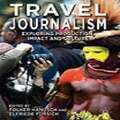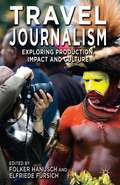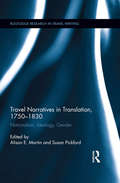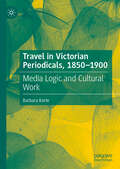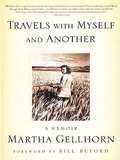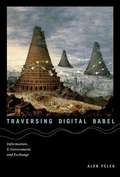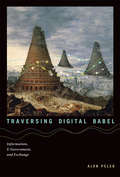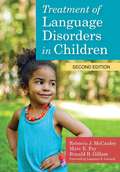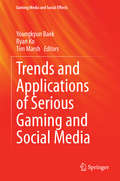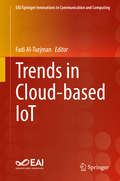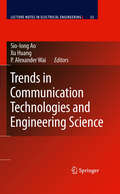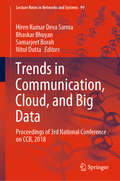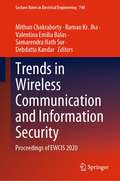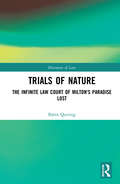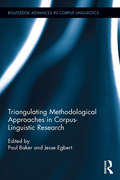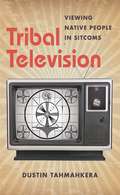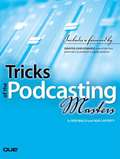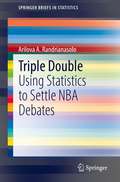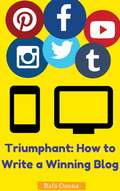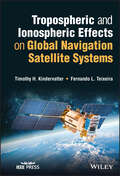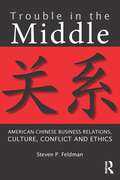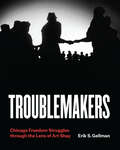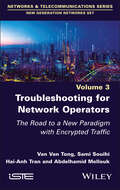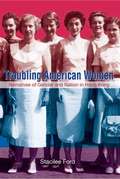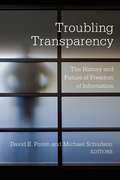- Table View
- List View
Travel Journalism
by Folker Hanusch Elfriede FürsichTravel journalism has experienced enormous growth over recent decades, with a record number of media organizations now involved in producing information for tourists in one way or another. Correspondingly, journalism and media scholars have begun to pay more attention to this phenomenon. This book gives a comprehensive overview of the burgeoning field of travel journalism studies. The contributors explore travel journalism in newspapers and magazines, on television and online, across a wide range of national and cultural contexts. Individual chapters provide critical discussions of theoretical approaches, present studies of production, content and impact, and explain how travel journalism can be understood through the lenses of postcolonialism, sustainability and cosmopolitanism. This fascinating account offers a thoroughly international and interdisciplinary perspective on an increasingly important field of journalism scholarship.
Travel Journalism: Exploring Production, Impact and Culture
by F. Hanusch E. FürsichContributors from diverse backgrounds explore a range of issues in relation to the media and journalism's role in ascribing meaning to tourism practices. This fascinating account offers a thoroughly international and interdisciplinary perspective on an increasingly important field of journalism scholarship.
Travel Narratives in Translation, 1750-1830: Nationalism, Ideology, Gender (Routledge Research in Travel Writing #6)
by Alison E. Martin Susan PickfordThis book examines how non-fictional travel accounts were rewritten, reshaped, and reoriented in translation between 1750 and 1850, a period that saw a sudden surge in the genre's popularity. It explores how these translations played a vital role in the transmission and circulation of knowledge about foreign peoples, lands, and customs in the Enlightenment and Romantic periods. The collection makes an important contribution to travel writing studies by looking beyond metaphors of mobility and cultural transfer to focus specifically on what happens to travelogues in translation. Chapters range from discussing essential differences between the original and translated text to relations between authors and translators, from intra-European narratives of Grand Tour travel to scientific voyages round the world, and from established male travellers and translators to their historically less visible female counterparts. Drawing on European travel writing in English, French, German, Spanish, and Portuguese, the book charts how travelogues were selected for translation; how they were reworked to acquire new aesthetic, political, or gendered identities; and how they sometimes acquired a radically different character and content to meet the needs and expectations of an emergent international readership. The contributors address aesthetic, political, and gendered aspects of travel writing in translation, drawing productively on other disciplines and research areas that encompass aesthetics, the history of science, literary geography, and the history of the book.
Travel in Victorian Periodicals, 1850-1900: Media Logic and Cultural Work
by Barbara KorteThis is the first study to explore the connections between the development of travel and the rapid expansion of the periodicals market in the second half of the nineteenth century in Britain. By the 1860s, travel articles had become a staple of the periodicals market and reached readers who might never have travelled far themselves or bought a travel book. This monograph demonstrates that the representation of travel in Victorian periodicals came in forms and with cultural functions that differed from book publication, and that this media-specific representation helped to inscribe travel into the Victorian lifeworld. Based on a corpus of several general-interest periodicals targeted at different audiences, this book investigates how different readers - the family, women, young people and the working classes - engaged with travel. It argues that travel articles in periodicals performed significant cultural work because they accommodated readers to travel.
Travels with Myself and Another: A Memoir
by Martha GellhornOut of a lifetime of travelling, Martha Gellhorn has selected her "best horror journeys". She bumps through rain-sodden, war-torn China to meet Chiang Kai-Shek, floats listlessly in search of u-boats in the wartime Caribbean and visits a dissident writer in the Soviet Union against her better judgement. Written with the eye of a novelist and an ironic black humour, what makes these tales irresistible are Gellhorns explosive and often surprising reactions. Indignant, but never righteous and not always right, through the crucible of hell on earth emerges a woman who makes you laugh with her at life, while thanking God that you are not with her.
Traversing Digital Babel
by Alon PeledThe computer systems of government agencies are notoriously complex. New technologies are piled on older technologies, creating layers that call to mind an archaeological dig. Obsolete programming languages and closed mainframe designs offer barriers to integration with other agency systems. Worldwide, these unwieldy systems waste billions of dollars, keep citizens from receiving services, and even -- as seen in interoperability failures on 9/11 and during Hurricane Katrina -- cost lives. In this book, Alon Peled offers a groundbreaking approach for enabling information sharing among public sector agencies: using selective incentives to "nudge" agencies to exchange information assets. Peled proposes the establishment of a Public Sector Information Exchange (PSIE), through which agencies would trade information. After describing public sector information sharing failures and the advantages of incentivized sharing, Peled examines the U.S. Open Data program, and the gap between its rhetoric and results. He offers examples of creative public sector information sharing in the United States, Australia, Brazil, the Netherlands, and Iceland. Peled argues that information is a contested commodity, and draws lessons from the trade histories of other contested commodities -- including cadavers for anatomical dissection in nineteenth-century Britain. He explains how agencies can exchange information as a contested commodity through a PSIE program tailored to an individual country's needs, and he describes the legal, economic, and technical foundations of such a program. Touching on issues from data ownership to freedom of information, Peled offers pragmatic advice to politicians, bureaucrats, technologists, and citizens for revitalizing critical information flows.
Traversing Digital Babel: Information, E-Government, and Exchange (Information Policy)
by Alon PeledA groundbreaking approach to information sharing among government agencies: using selective incentives to “nudge” them to exchange information assets.The computer systems of government agencies are notoriously complex. New technologies are piled on older technologies, creating layers that call to mind an archaeological dig. Obsolete programming languages and closed mainframe designs offer barriers to integration with other agency systems. Worldwide, these unwieldy systems waste billions of dollars, keep citizens from receiving services, and even—as seen in interoperability failures on 9/11 and during Hurricane Katrina—cost lives. In this book, Alon Peled offers a groundbreaking approach for enabling information sharing among public sector agencies: using selective incentives to “nudge” agencies to exchange information assets. Peled proposes the establishment of a Public Sector Information Exchange (PSIE), through which agencies would trade information. After describing public sector information sharing failures and the advantages of incentivized sharing, Peled examines the U.S. Open Data program, and the gap between its rhetoric and results. He offers examples of creative public sector information sharing in the United States, Australia, Brazil, the Netherlands, and Iceland. Peled argues that information is a contested commodity, and draws lessons from the trade histories of other contested commodities—including cadavers for anatomical dissection in nineteenth-century Britain. He explains how agencies can exchange information as a contested commodity through a PSIE program tailored to an individual country's needs, and he describes the legal, economic, and technical foundations of such a program. Touching on issues from data ownership to freedom of information, Peled offers pragmatic advice to politicians, bureaucrats, technologists, and citizens for revitalizing critical information flows.
Treatment of Language Disorders in Children (Second Edition)
by Alan G. Kamhi Marc E. Fey<p>Thoroughly updated to meet the needs of today's students in SLP courses, the second edition of this classic textbook prepares future professionals to evaluate, compare, select, and apply effective interventions for language disorders in children. Using realistic case studies and many new video clips that show each strategy in action, the expert contributors introduce your students to 14 current, research-based intervention models and examine practical ways to apply them in the field. <p>The new edition covers interventions for both emerging communication and language and more advanced language and literacy, in a consistent chapter format that makes it easy for students to compare treatment approaches. A textbook SLPs will keep and reference often throughout their careers, this balanced, in-depth look at interventions will prepare professionals to choose and implement the best interventions for children with language disorders.</p>
Trends and Applications of Serious Gaming and Social Media
by Youngkyun Baek Ryan Ko Tim MarshThis book highlights the challenges and potential of educational learning or industry-based training using serious games and social media platforms. In particular, the book addresses applications used in businesses and education-related organizations in Asia, where the framework and experience of serious games have been used to address specific problems in the real world. The topics that will be present in this book includes future of serious games and immersive technologies and their impact on society; online and mobile games; achievement systems in serious games; persuasive technology and games for saving and money management; malware analytics for social networking; serious games for mental health interventions; educational implications of social network games; learning and acquiring subject knowledge using serious games in classrooms. The target audience for this book includes scientists, engineers and practitioners involved in the field of Serious Games. The major part of this book comprises of papers that have been presented at the Serious Games and Social Connect 2012 conference held in Singapore (October 4, 2012). All the contributions have been peer reviewed and by scientific committee members with report about quality, content and originality.
Trends in Cloud-based IoT (EAI/Springer Innovations in Communication and Computing)
by Fadi Al-TurjmanThis book examines research topics in IoT and Cloud and Fog computing. The contributors address major issues and challenges in IoT-based solutions proposed for the Cloud. The authors discuss Cloud smart and energy efficient services in applications such as healthcare, traffic, and farming systems. Targeted readers are from varying disciplines who are interested in designing and deploying the Cloud applications. The book can be helpful to Cloud-based IoT service providers, Cloud-based IoT service consumers, and Cloud service developers in general for getting the state-of-the-art knowledge in the emerging IoT area. The book also provides a strong foundation for researchers to advance further in this domain. Presents a variety of research related to IoT and Cloud computing; Provides the industry with new and innovative operational ideas; Pertinent to academics, researchers, and practitioners around the world.
Trends in Communication Technologies and Engineering Science
by He Huang"Trends in Communication Technologies and Engineering Science" contains revised and extended research articles written by prominent researchers participating in a large international conference on Advances in Communication Technologies and Engineering Science. The conference is held in Hong Kong, March 19-21, 2008. Topics covered include communications theory, communications protocols, network management, wireless networks, telecommunication, electronics, power engineering, control engineering, signal processing, and industrial applications. "Trends in Communication Technologies and Engineering Science" offers tremendous state of the art advances in communication systems and engineering science which also serves as an excellent reference work for researchers and graduate students working on communication technologies and engineering science.
Trends in Communication, Cloud, and Big Data: Proceedings of 3rd National Conference on CCB, 2018 (Lecture Notes in Networks and Systems #99)
by Samarjeet Borah Nitul Dutta Hiren Kumar Deva Sarma Bhaskar BhuyanThis book presents the outcomes of the Third National Conference on Communication, Cloud and Big Data (CCB) held on November 2–3, 2018, at Sikkim Manipal Institute of Technology, Majitar, Sikkim. Featuring a number of papers from the conference, it explores various aspects of communication, computation, cloud, and big data, including routing in cognitive radio wireless sensor networks, big data security issues, routing in ad hoc networks, routing protocol for Internet of things (IoT), and algorithm for imaging quality enhancement.
Trends in Wireless Communication and Information Security: Proceedings of EWCIS 2020 (Lecture Notes in Electrical Engineering #740)
by Valentina Emilia Balas Debdatta Kandar Samarendra Nath Sur Mithun Chakraborty Raman Kr. JhaThis book presents best selected papers presented at the International Conference on Emerging Wireless Communication Technologies and Information Security (EWCIS 2020), held from 8th & 9th October 2020 at Amity University Jharkhand, Ranchi, India. The book includes papers in the research area of wireless communications and intelligent systems, signal and image processing in engineering applications, data communication and information security, IoT and cloud computing. The contribution ranges from scientists, engineers and technologists from academia as well as from industry.
Trials of Nature: The Infinite Law Court of Milton's Paradise Lost
by Björn QuiringFocusing on John Milton’s Paradise Lost , this book investigates the meta-phorical identifi cation of nature with a court of law – an old and persistent trope, haunted by ancient aporias, at the intersection of jurisprudence, phi-losophy and literature. In an enormous variety of texts, from the Greek beginnings of Western literature onward, nature has been described as a courtroom in which an all- encompassing trial takes place and a universal verdict is executed. The first, introductory part of this study sketches an overview of the metaphor’s development in European history, from antiquity to the seventeenth century. In its second, more extensive part, the book concentrates on Milton’s epic Paradise Lost in which the problem of the natural law court finds one of its most fascinating and detailed articulations. Using conceptual tools provided by Hannah Arendt, Walter Benjamin, Hans Blumenberg, Gilles Deleuze, William Empson and Alfred North Whitehead, the study demonstrates that the conflicts in Milton’s epic revolve around the tension between a universal legal procedure inherent in nature and the positive legal decrees of the deity. The divine rule is found to consolidate itself by Nature’s supple-mentary shadow government; their inconsistencies are not flaws, but rather fundamental rhetorical assets, supporting a law that is inherently “double- formed”. In Milton’s world, human beings are thus confronted with a twofold law that entraps them in its endlessly proliferating double binds, whether they obey or not. The analysis of this strange juridical structure can open up new perspectives on Milton’s epic, as well as on the way legal discourse tends to entangle norms with facts and thus to embed itself in human life. This original and intriguing book will appeal not only to those engaged in the study of Milton, but also to anyone interested in the relationship between law, history, literature and philosophy.
Triangulating Methodological Approaches in Corpus Linguistic Research (Routledge Advances in Corpus Linguistics)
by Paul Baker Jesse EgbertContemporary corpus linguists use a wide variety of methods to study discourse patterns. This volume provides a systematic comparison of various methodological approaches in corpus linguistics through a series of parallel empirical studies that use a single corpus dataset to answer the same overarching research question. Ten contributing experts each use a different method to address the same broadly framed research question: In what ways does language use in online Q+A forum responses differ across four world English varieties (India, Philippines, United Kingdom, and United States)? Contributions will be based on analysis of the same 400,000 word corpus from online Q+A forums, and contributors employ methodologies including corpus-based discourse analysis, audience perceptions, Multi-Dimensional analysis, pragmatic analysis, and keyword analysis. In their introductory and concluding chapters, the volume editors compare and contrast the findings from each method and assess the degree to which ‘triangulating’ multiple approaches may provide a more nuanced understanding of a research question, with the aim of identifying a set of complementary approaches which could arguably take into account analytical blind spots. Baker and Egbert also consider the importance of issues such as researcher subjectivity, type of annotation, the limitations and affordances of different corpus tools, the relative strengths of qualitative and quantitative approaches, and the value of considering data or information beyond the corpus. Rather than attempting to find the ‘best’ approach, the focus of the volume is on how different corpus linguistic methodologies may complement one another, and raises suggestions for further methodological studies which use triangulation to enrich corpus-related research.
Tribal Television
by Dustin TahmahkeraNative Americans have been a constant fixture on television, from the dawn of broadcasting, when the iconic Indian head test pattern was frequently used during station sign-ons and sign-offs, to the present. In this first comprehensive history of indigenous people in television sitcoms, Dustin Tahmahkera examines the way Native people have been represented in the genre. Analyzing dozens of television comedies from the United States and Canada, Tahmahkera questions assumptions that Native representations on TV are inherently stereotypical and escapist. From The Andy Griffith Show and F-Troop to The Brady Bunch, King of the Hill, and the Native-produced sitcom, Mixed Blessings, Tahmahkera argues that sitcoms not only represent Native people as objects of humor but also provide a forum for social and political commentary on indigenous-settler relations and competing visions of America. Considering indigenous people as actors, producers, and viewers of sitcoms as well as subjects of comedic portrayals, Tribal Television underscores the complexity of Indian representations, showing that sitcoms are critical contributors to the formation of contemporary indigenous identities and relationships between Native and non-Native people.
Tricks of the Podcasting Masters
by Rob Walch Mur LaffertyThis book gives detailed instructions for putting together your own podcasts. It also reviews the history of podcasting. Everything you ever wanted to know about podcasts is probably here.
Triple Double: Using Statistics to Settle NBA Debates (SpringerBriefs in Statistics)
by Arilova A. RandrianasoloThis book provides empirical evidence and statistical analyses to uncover answers to some of the most debated questions in the NBA. The sports world lives and breathes off of debates on who deserves an MVP award, and which athletes should be considered all-stars. This book provides some statistics-backed perspectives to some of these debates that are specific to the NBA. Was LeBron snubbed of an MVP in the 2010-2011 season? Why has the G.O.A.T. debate turned into LeBron vs. Jordan….Did Kobe get overlooked? How come Klay Thompson didn’t get All-NBA honors in the 2018-2019 season? This book explores these questions and many more with empirical evidence. This book is invaluable for any undergraduate or masters level course in sport analytics, sports marketing, or sports management. It will also be incredibly useful for scouts, recruiters, and general managers in the NBA who would like to use analytics in their work.
Triumphant: How to Write a Winning Blog
by Rafa Osuna Grant YoderAre you thinking about starting a blog? Do you already have a blog but you're just not quite sure what to do with it? If the answer is yes, then this book is for you. What exactly will you find in this book? Well, how about I start by telling you what you won't find. In this book you're not going to find cheap blogging philosophy. You know, the kinds of tips and tricks people try to sell you even when they themselves have never had any blogging success. In this book you're not going to find a "Blogging 101" type of course on the technical details of how to start a blog. In today's world, blog creation platforms are so intuitive and easy to use that it wouldn't even be worth your time to read a book like that. So if that's the kind of thing you're looking for, I'd recommend you check out one of the many "How to create a blog" tutorials that you can find on YouTube, among other places. Another thing you won't find in this book is a magic formula for "how to become a blogging millionaire in two weeks." Believe me, if anyone offers you anything that sounds like that, run away...immediately. What you will find in this book is a short summary of what I've written in my personal blog (El Último Blog) over the last ten years. In these ten years I have not only maintained my own personal blog, but I have also directed a blogging network with over 50 other writers, I've given conferences and taught classes on blogging, I've contributed to various book publications, etc. What I hope to share with you in this book, as a summary of these past ten years of blogging, is a selection of 15 articles which I believe reflect, in a clear and concise way, everything you'll need in order to write a winning blog. These articles will be just 15 out of the 2,000 plus articles that I have published over the years. I've taken the original versions and touched them up a bit, so that while the
Tropospheric and Ionospheric Effects on Global Navigation Satellite Systems
by Timothy H. Kindervatter Fernando L. TeixeiraTropospheric and Ionospheric Effects on Global Navigation Satellite Systems Explore atmospheric effects on radio frequency propagation in the context of Global Navigation Satellite System communication In Tropospheric and Ionospheric Effects on Global Navigation Satellite Systems, a team of distinguished researchers deliver an accessible and authoritative introduction to all scientifically relevant effects caused by the ionosphere and troposphere on GNSS RF signals. The book explores the origin of each type of propagation effect and explains it from a fundamental physical perspective. Each of the major methods used for the measurement, prediction, and mitigation of ionospheric and tropospheric effects on GNSS are discussed in detail. The authors also provide the mechanisms that drive ionization and plasma transport in the ionosphere, propagation phenomena (including scattering, absorption, and scintillations), and the predominant predictive models used to predict ionospheric propagation effects. With an emphasis on global navigation satellite systems, the book discusses the US Standard Atmosphere, a general reference model for characteristics of the unionized atmosphere. It also considers: Thorough introductions to the Global Positioning System and the principles of GNSS positioning Comprehensive explorations of tropospheric propagation and predictive models of the troposphere Practical discussions of the physics of the ionosphere, experimental observation of the ionosphere, and ionospheric propagation In-depth examinations of predictive models of the ionosphere, including group delay models for single-frequency GNSS receivers Ideal for engineers and research scientists with a professional or personal interest in geophysics, RF propagation, and GNSS and GPS applications, Tropospheric and Ionospheric Effects on Global Navigation Satellite Systems will also earn a place in the libraries of undergraduate and graduate students studying RF propagation or GNSS.
Trouble in the Middle: American-Chinese Business Relations, Culture, Conflict, and Ethics
by Steven P. FeldmanThis book will help readers better understand the ethical and cultural assumptions that both American and Chinese business cultures bring to business relationships in China. It analyzes the relationships developed between the two cultures, areas where they conflict, and how these conflicts are (or are not) resolved. These relationships are investigated in three stages. The author: describes and interprets American business experience in China describes and interprets Chinese business experience in China, including interaction with Americans compares these two business cultures as they are experienced in China to investigate the relationships between them, centering the cultural analysis on ethical issues. Feldman's thorough research gets to the crux of how American and Chinese executives perceive the ethical and cultural aspects of doing business. The result is a book that will prove helpful to all those looking to expertly navigate Chinese-American business relationships.
Troublemakers: Chicago Freedom Struggles through the Lens of Art Shay
by Erik S. Gellman“Shay’s stunning photos and Gellman’s historical narrative pack a one-two punch . . . an exhilarating lens through which to view one city’s struggle for justice.” —Alex Kotlowitz, author of An American SummerWhat does democracy look like? And when should we cause trouble to pursue it? Troublemakers fuses photography and history to demonstrate how racial and economic inequality gave rise to a decades-long struggle for justice in one American city.In dialogue with 275 of Art Shay’s photographs—many not previously published—Erik S. Gellman takes a new look at major developments in postwar US history: the Second Great Migration, “white flight,” and neighborhood and street conflicts, as well as shifting party politics and the growth of the carceral state. The result is a visual and written history that complicates—and even upends—the morality tales and popular memory of postwar freedom struggles.Shay himself was a “troublemaker,” seeking to unsettle society by illuminating truths that many middle-class, white, media, political, and businesspeople pretended did not exist. Shay served as a navigator in the US Army Air Forces during World War II, then took a position as a writer for Life magazine. But soon after his 1948 move to Chicago, he decided to become a freelance photographer. Shay wandered the city photographing whatever caught his eye—and much did. His lens captured everything from private moments of rebellion to era-defining public movements, as he sought to understand the creative and destructive energies that propelled freedom struggles in the Windy City.Shay illuminated the pain and ecstasy that sprung up from the streets of Chicago, while Gellman reveals their collective impact on the urban fabric and on our national narrative. This collaboration offers a fresh and timely look at how social conflict can shape a city—and may even inspire us to make trouble today.“Fascinating.” —Chicago Tribune
Troubleshooting for Network Operators: The Road to a New Paradigm with Encrypted Traffic
by Abdelhamid Mellouk Sami Souihi Van Van Tong Hai-Anh TranNowadays, the Internet is becoming more and more complex due to an everincreasing number of network devices, various multimedia services and a prevalence of encrypted traffic. Therefore, in this context, this book presents a novel efficient multi modular troubleshooting architecture to overcome limitations related to encrypted traffic and high time complexity. This architecture contains five main modules: data collection, anomaly detection, temporary remediation, root cause analysis and definitive remediation. In data collection, there are two sub modules: parameter measurement and traffic classification. This architecture is implemented and validated in a software-defined networking (SDN) environment.
Troubling American Women
by Stacilee FordAmerican women have lived in Hong Kong, and in neighboring Macao, for nearly two centuries. Many were changed by their encounter with Chinese life and British colonialism. Their openness to new experiences set them apart, while their "pedagogical impulse" gave them a reputation for outspokenness that troubled others. Drawing on memoirs, diaries, newspapers, films, and other texts, Stacilee Ford tells the stories of several American women and explores how, through dramatically changing times, they communicated their notions of national identity and gender. Troubling American Womenis a lively and provocative study of cross-cultural encounters between the Hong Kong and the US and use of stereotypes of American womanhood in Hong Kong popular culture. Stacilee Fordhas lived in Hong Kong for 18 years. She teaches history and American studies at the University of Hong Kong.
Troubling Transparency: The History and Future of Freedom of Information
by Michael Schudson David E. PozenToday, transparency is a widely heralded value, and the U.S. Freedom of Information Act (FOIA) is often held up as one of the transparency movement’s canonical achievements. Yet while many view the law as a powerful tool for journalists, activists, and ordinary citizens to pursue the public good, FOIA is beset by massive backlogs, and corporations and the powerful have become adept at using it for their own interests. Close observers of laws like FOIA have begun to question whether these laws interfere with good governance, display a deleterious anti-public-sector bias, or are otherwise inadequate for the twenty-first century’s challenges.Troubling Transparency brings together leading scholars from different disciplines to analyze freedom of information policies in the United States and abroad—how they are working, how they are failing, and how they might be improved. Contributors investigate the creation of FOIA; its day-to-day uses and limitations for the news media and for corporate and citizen requesters; its impact on government agencies; its global influence; recent alternatives to the FOIA model raised by the emergence of “open data” and other approaches to transparency; and the theoretical underpinnings of FOIA and the right to know. In addition to examining the mixed legacy and effectiveness of FOIA, contributors debate how best to move forward to improve access to information and government functioning. Neither romanticizing FOIA nor downplaying its real and symbolic achievements, Troubling Transparency is a timely and comprehensive consideration of laws such as FOIA and the larger project of open government, with wide-ranging lessons for journalism, law, government, and civil society.
